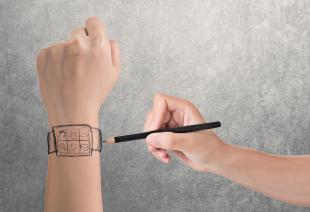Wearable Technology—What's the Big Deal?


In the technology world, it seems like every week brings with it a new tech craze. And while some fizzle and die, others—like wearable technology— are making a name for themselves and becoming increasingly popular. Some people are even estimating these so called “wearables” will take off and become as big as smart phones. But for those of you who are still confused or unsure about this new technology and what it can do, read on!
The Basics
The most common and well known form of wearable technology today is fitness trackers worn on your wrist (or elsewhere!). These can come in many different shapes and with various features, but the three most common are the Nike+ Fuelband, the FitBit, and Jawbone. What do they do? These devices track your movement and help you to monitor your health through various techniques. Set a goal for how much you want to move during the day (10,000 steps? 3,000 Fuelpoints?) and become more motivated to walk those extra few steps or go for a run in order to reach your daily goal. Some of these devices even monitor your food and calorie intake and even sleep tracking to help you understand your quality of sleep and see if it is affecting your health.
The Possibilities
Everyone has heard of the industry giant Google Glass, the wearable glasses that allow you to take pictures and view a small screen in the corner of your vision that no one else can see, but with the ever increasing popularity of the basic wearable devices, many companies are exploring the technology and forging a path of their own in the wearable industry. There’s now wearable direction shoes that vibrate to help you get where you need to go. Simply program the destination into the app on your phone which syncs via bluetooth to your shoes, and when you need to make a turn, one of your shoes will vibrate in the direction you need to go.
Another new wearable helping you with directions is the Recon Heads-Up Display, with a goggle model for skiiers and a sunglass model for cyclists. Similar to the wearing style of Google Glass, the Recon technology is unique by allowing athletes to continue to push themselves while providing them with information they’re never had access to before even more information. Snow-goers and cyclists can see their speed, heart rate, a map with their location, compare themselves with their friends, and more all while continuing to move and without having to be staring down at their phone.
Wearables are not just for athletes or even adults anymore, there are multiple medical devices and aids, such as a wearable baby monitor. At first you might question how a baby monitor can be considered a medical device, but the ingenious piece of technology connects parents with their baby in a whole new way. The device is worn on the baby’s ankle and syncs via bluetooth to a companion phone app which alerts you if your baby stops breathing or is in distress, and allows you to monitor your baby’s sleep, heart rate, temperature (of both the baby and the room), and more!
Having Commitment Issues?
Monitoring your health and tracking your fitness may seem like a great idea, but it can come at a bit of a high price point for some, especially if you are not sure which one to get or how to go about improving your lifestyle. If you aren’t sure you want to make the commitment to wearables just yet, see if you can make a few healthy lifestyle changes of your own to get yourself and your family on the right track and making healthier life choices.



